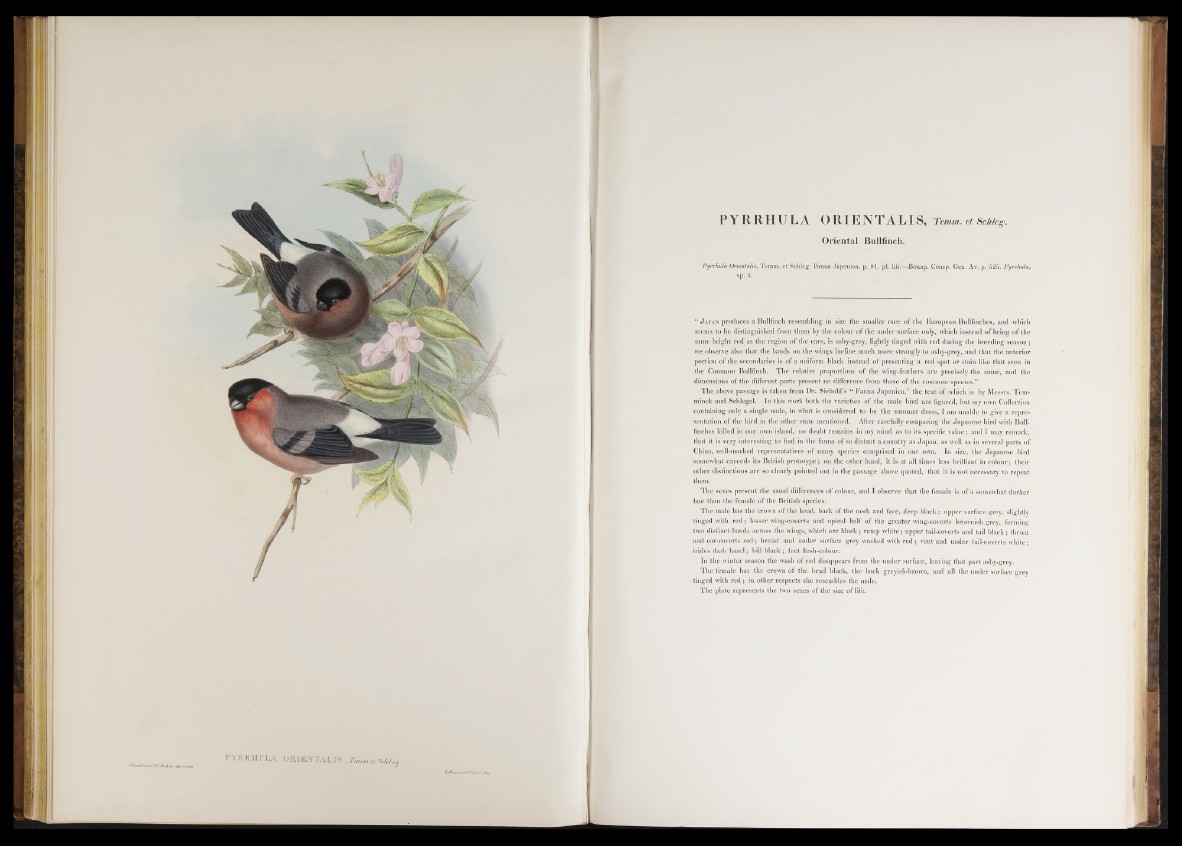
P T 1 R M JLA Ü JK D EM T á JU S „ T a n .m .a SM « ,
PYRRHULA ORIENTALIS , Temm. et Schleg.
Oriental Bullfinch.
Pyrrhula Orientalis, Temm. e t Schleg. Fauna Japónica, p. 91. pi. liii.—Bonap. Consp. Gen Av. p. 525. Pyrrhula,
sp. 3.
“ J a p a n produces a Bullfinch resembling in size the smaller race of the European Bullfinches, and which
seems to be distinguished from them by the colour of the under-surface only, which instead of being of the
same bright red as the region o f the ears, is ashy-grey, lightly tinged with red during the breeding season 5
we observe also that the bands on the wings incline mucb more strongly to ashy-grey, and that the anterior
portion of the secondaries is of a uniform black instead o f presenting a red spot or stain like that seen in
the Common Bullfinch. The relative proportions of the wing-feathers are precisely the same, and the
dimensions o f the different parts present no difference from those o f the common species.”
The above passage is taken from Dr. Siebold’s “ Fauna Japónica,” the text of which is by Messrs. Tem-
minck and Schlegel. In this work both the varieties of the male bird are figured, but my own Collection
containing only a single male, in what is considered to be the summer dress, I am unable to give a representation
of the bird in the other state mentioned. After carefully comparing the Japanese bird with Bullfinches
killed in our own island, no doubt remains in my mind as to its specific value; and I may remark,
that it is very interesting to find in the fauna of so distant a country as Japan, as well as in several parts of.
China, well-marked representatives o f many species comprised in our own. In size, the Japanese bird
somewhat exceeds its British prototype; on the other hand, it is at all times less brilliant in colour; their
other distinctions are so clearly pointed out in the passage above quoted, that it is not necessary to repeat
them.
The sexes present the usual differences of colour, and I observe that the female is of a somewhat darker
hue than the female of the British species.
The male has the crown of the head, back of the neck and face, deep black; upper surface grey, slightly
tinged with r e d ; lesser wing-coverts and apical half of the greater wing-coverts brownish grey, forming
two distinct bands across the wings, which are black; rump white; upper tail-coverts and tail black: throat
and ear-coverts r e d ; breast and under surface grey washed with r e d ; vent and under tail-coverts white;
irides dark hazel; bill black; feet flesh-colour.
In the winter season the wash of red disappears from the under surface, leaving that part ashy-grey.
The female has the crown of the head black, the back greyisli-brown, and all the under surface grey
tinged with r e d ; in other respects she resembles the male.
The plate represents the two sexes of the size of life.